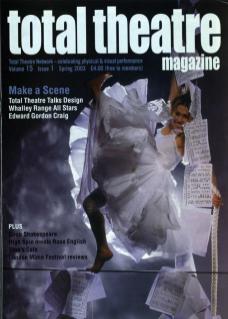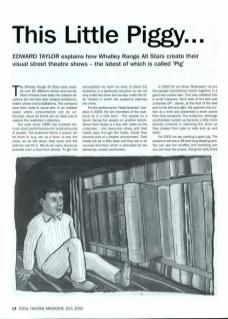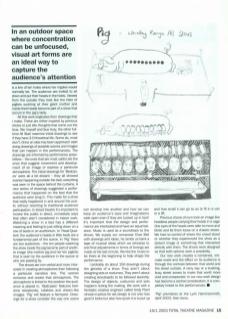The Whalley Range All Stars have created over 60 different shows and events.
Most of these have been for outdoor situations but we have also created exhibitions, indoor shows and installations. The company have their roots in visual arts. In an outdoor space where concentration can be unfocused, visual art forms are an ideal way to capture the audience's attention.
Our work since 1999 has involved intimate short performances for small amounts of people. The audience forms a queue, we let them in (e.g. ten at a time) to see the show, we do the show, they leave and the next ten are let in. We do as many shows as possible over a four-hour period. To get the atmosphere we want we have to place the audience in a particular situation so we not only make the show but we also make the little theatre in which the audience watches the show.
For the performance Head Quarters (created in 2000) the ten members of the audience sit in a little barn – five people on a bench facing five people on another bench. Above their heads is a box with holes on the underside – this descends slowly and their heads pass through the holes. Inside they become part of a theatre environment. Their heads are all in little beds and they are in an unusual dormitory which is animated by two previously unseen performers.
In 2002 for our show Bedcases we put five people (sometimes more!) together in a giant four poster bed. This was wheeled into a small marquee. Each side of the bed was curtained off-above, at the foot of the bed and to the left and right. We opened one curtain at a time and presented a short scene from that viewpoint. The audience, although comfortably tucked up became a little more actively involved in watching the show as they looked from side to side and up and down.
For 2003 we are creating a giant pig. The audience will see a 28-foot long sleeping sow. You can see her snuffles and twitching ear. You can hear her snores. Along her belly there is a line of ten holes where her nipples would normally be. The audience are invited to sit down and put their heads in the holes. Viewed from the outside they look like the litter of piglets suckling at their giant mother and inside their heads become part of a show that occurs in the pig's belly.
In an outdoor space where concentration can be unfocused, visual art forms are an ideal way to capture the audience's attention.
All this work originates from drawings that I make. These are either inspired by previous shows or just idle thoughts that come out the blue. We (myself and Sue Auty, the other full-time All Star) examine initial drawings to see if they have 3D theatrical life. Some do, most don't. Once an idea has been approved I start doing drawings of possible scenes and images that can happen in the performances. The drawings are informed by performance possibilities – the ones that are most useful are the ones that suggest movement and development of an image or express a particular atmosphere. The initial drawings for Bedcases were all a bit distant – they all showed scenes happening outside the bed, everything was seen in the space behind the curtains. A new series of drawings suggested a performance that happened on the bed that the audience were lying in. This made for a show that really happened in and around the public without resorting to traditional audience participation. In street theatre it's important to involve the public in direct, immediate ways that often aren't considered in indoor work. Watching a show in a bed has a different meaning and feeling to just sitting down on a row of seats in an auditorium. In Head Quarters the audience's heads in little beds are a fundamental part of the scene. In Pig there are two audiences – the ten people watching the show inside the pig become part of another image (the mother pig and her ten piglets) that is seen by the audience in the queue or who are passing by.
The shows are non-verbal and more interested in creating atmospheres than following a particular narrative line. The scenes enhance and create that atmosphere. The atmosphere is linked to the position the audience is placed in. Bedcases features bedtime storybooks, lullabies and dream-like images. Pig will feature a farmyard. Drawings for a show consider the way one scene can develop into another and how we can keep an audience's eyes and imaginations wide open even if they are tucked up in bed! It's important that the design and performance are interlocked and have an equal balance. Music is used as a soundtrack to the shows. We supply our composer Clive Bell with drawings and ideas, he sends us back a tape of musical ideas which we rehearse to and final adjustments in terms of timings are made at the last minute. We like the music to be there at the beginning to help shape the performance.
I probably do about 150 drawings during the genesis of a show. They aren't about designing sets or costumes. They aren't about creating storyboards to be followed slavishly. The design of objects, costumes and sets happens during the making. We work with a fantastic creative engineer called Andy Plant whose impetus for set design is not only how good it looks but also how quick it is to put up and how small it can go so as to fit in a van or a lift.
Previous shows of ours took an image like headless people carrying their heads in a cage (the eyes of the heads were able to move and blink) and let them loose on a chaotic street. We had no control of where the crowd stood or whether they experienced the show as a distant image or something that interacted directly with them. The shows were designed so that both options were a possibility.
Our new work creates a contained, intimate world and the effect on its audience is through the contrast between that world and the street outside. A rainy day or a bustling, busy street serves to make that world more vivid and unexpected. In our new work design has become a central consideration. It is completely linked to the performances.
Pig premieres at the Lyric Hammersmith, April 2003, then tours.


